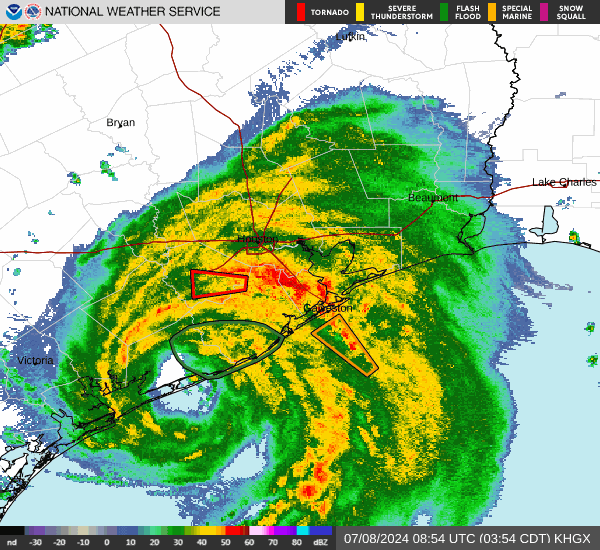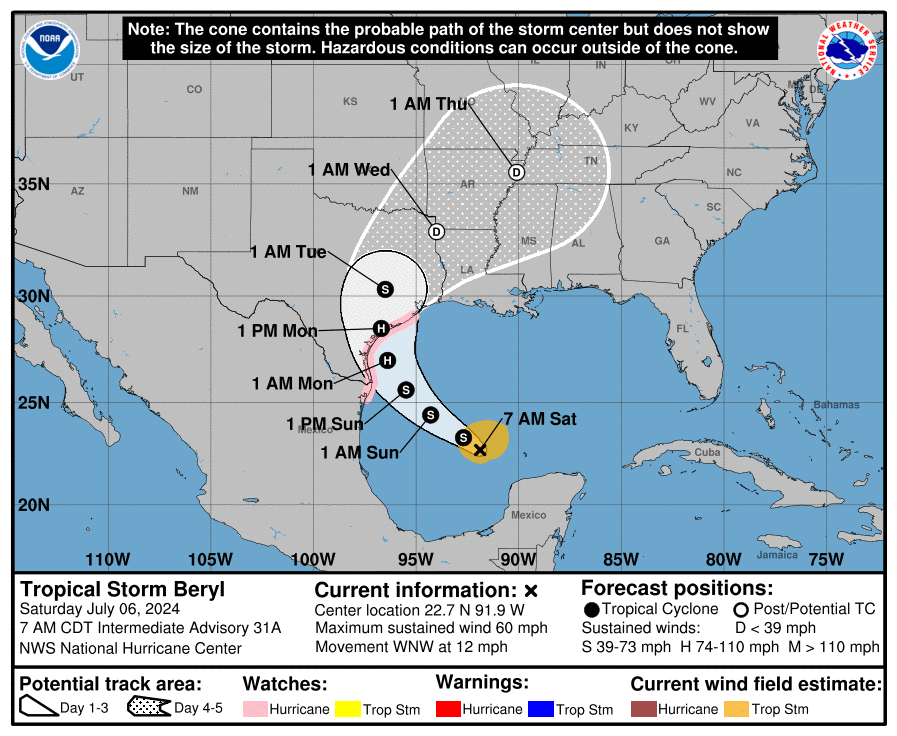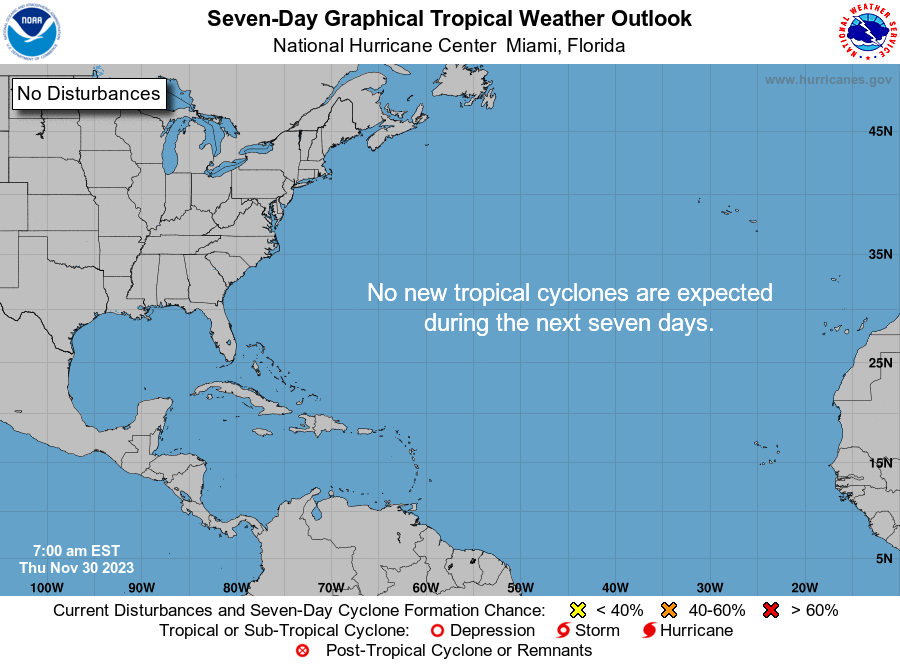Hurricane Beryl strengthens before making landfall along Texas coast as Category 1 storm
Hurricane Beryl made landfall along the Texas coast around 4:30 a.m. as a Category 1 storm.
As expected, Beryl strengthened as it approached the coast. By the time it made landfall near Matagorda, winds had increased to 80 mph, according to the National Hurricane Center.
➤ Live updates: Get the latest on Hurricane Beryl after its Texas landfall
Minutes after landfall, the National Weather Service in Houston issued a tornado warning for several locations until 4 a.m. CDT. Flash flood warnings were issued for several communities until 6:45 a.m. CDT.
It was the hurricane's third landfall in eight days.
Dangerous storm surge and strong winds are occurring and flash floods are expected, according to the 5 a.m. advisory from the National Hurricane Center. Beryl also could bring 5 to 10 inches of rain. Rainfall of up to 15 inches was also expected in portions of the middle and upper Texas Gulf Coast and eastern Texas.
Beryl becomes first July hurricane to hit Texas since 2020
#HurricaneBeryl has made landfall as a Category 1 #hurricane near Matagorda, TX with max winds of 80 mph - the first July hurricane landfall in Texas since Hanna (2020) and the 10th July Texas hurricane landfall on record (since 1851). pic.twitter.com/SZJicTO5Ut
— Philip Klotzbach (@philklotzbach) July 8, 2024
Beryl was the first storm to cross the entire Caribbean as a named storm and continue to make landfall on the western Gulf of Mexico coast since Dean in 2007. It'll also be the first storm to make landfall in Texas since Allen in 1980, according to Dr. Rick Knabb, hurricane expert at The Weather Channel.
Three hurricanes have made landfall in Texas in July since 2000: Claudette in 2003, Dolly in 2008 and Hanna in 2020, according to Philip Klotzbach, meteorologist at Colorado State University specializing in Atlantic basin seasonal hurricane forecasts.
Its the 10th time a hurricane has hit Texas in July since records began in 1851, Klotzbach said.
Track Hurricane Beryl: See radar images as Beryl moves into Texas

Beryl heading toward its third landfall in a week
On Monday, July 1, Beryl was a powerful Category 4 hurricane that hit Carriacou Island, Grenada, with 150-mph winds.
On Friday, July 5, Beryl weakened into a tropical storm, but made landfall near Tulum, Mexico, on the Yucatan Peninsula as a Category 2 storm, according to the National Hurricane Center. That was Beryl's second landfall in a week. By then, the storm was moving ashore as a Category 2 with 110-mph winds.
While Beryl weakened into a tropical storm as it passed over the Yucatan Peninsula, it strengthened before making landfall near Matagorda, Texas, as a Category 1 hurricane with 80-mph winds.
How is Beryl expected to impact Florida, Gulf Coast, US?
Rip currents will cause life-threatening beach conditions through Monday across much of the Gulf Coast, according to the National Hurricane Center.
"Beryl's impacts will not end in Texas, but rather expand across the central states and into a portion of the Great Lakes later in the week," AccuWeather forecasters said. "Flooding rains and even a few twisters will be the primary concerns as what is left of the storm works its way through the nation's heartland."
Webcams show power of Hurricane Beryl along Texas coast
Here's the latest update from the NHC as of 5 a.m. Monday, July 8:
Spaghetti models: Where will Hurricane Beryl go next?
Special note about spaghetti models: Illustrations include an array of forecast tools and models, and not all are created equal. The Hurricane Center uses only the top four or five highest performing models to help make its forecasts.
Hurricane Beryl: What you need to know

Location: eye located over Matagorda, Texas; 85 miles south-southwest of Houston, Texas
Maximum sustained winds: 80 mph
Movement: north at 12 mph
Watches and warnings issued for Tropical Storm Beryl
Hurricane warning: A hurricane warning is in effect for the following:
The Texas coast from Mesquite Bay northward to Port Bolivar
A hurricane warning means that hurricane conditions are expected somewhere within the warning area. A warning is typically issued 36 hours before the anticipated first occurrence of tropical-storm-force winds, conditions that make outside preparations difficult or dangerous. Preparations to protect life and property should be rushed to completion.
Tropical storm warning: A tropical storm warning is in effect for the following:
The Texas coast north of Port Bolivar to Sabine Pass
A tropical storm warning means that tropical storm conditions are expected somewhere within the warning area within 36 hours.
Storm surge warning: A storm surge warning is in effect for the following:
Mesquite Bay to Sabine Pass, including Matagorda Bay and Galveston Bay
A storm surge warning means there is a danger of life-threatening inundation, from rising water moving inland from the coastline, in the indicated locations. This is a life-threatening situation. Persons located within these areas should take all necessary actions to protect life and property from rising water and the potential for other dangerous conditions. Follow evacuation and other instructions from local officials.
Hurricane Beryl: Here's latest information on strength, forecast path
At 5 a.m. EDT, the center of Hurricane Beryl was located near latitude 28.6 North, longitude 96.0 West.
Beryl is moving toward the north near 12 mph. A turn toward the northeast with an increase in forward speed is expected tonight and Tuesday.
On the forecast track, the center of Beryl will move over eastern Texas today, then move through the Lower Mississippi Valley into the Ohio Valley on Tuesday and Wednesday.
Reports from an Air Force Reserve Hurricane Hunter aircraft and National Weather Service Doppler radar data indicate that maximum sustained winds are near 80 mph, with higher gusts.
Steady to rapid weakening is expected as the center moves inland, and Beryl is expected to weaken to a tropical storm later today and to a tropical depression on Tuesday.
Hurricane-force winds extend outward up to 45 miles from the center and tropical-storm-force winds extend outward up to 115 miles.
A National Ocean Service Station near Freeport, Texas, recently reported a sustained wind of 71 mph and a wind gust of 87 mph. A WeatherFlow station at Surfside Beach, Texas, recently reported a wind gust of 85 mph.
The latest minimum central pressure reported by the Hurricane Hunter aircraft is 979 mb. Weatherflow and National Ocean Service stations near Matagorda recently reported pressures near 981 mb inside the eye of Beryl.
How strong is Beryl and where is it going?
Here's how strong Beryl is expected to get:
Currently: 70 mph
12 hours: 75 mph, inland
24 hours: 45 mph
36 hours: 35 mph
48 hours: 30 mph
60 hours: 25 mph
72 hours: 25 mph
96 hours: dissipated
Key messages from the National Hurricane Center: What you need to know about Hurricane Beryl
There is a danger of life-threatening storm surge inundation along the coast of Texas from Mesquite Bay to Sabine Pass, including Matagorda Bay and Galveston Bay. Residents in those areas should follow any advice given by local officials and follow evacuation orders.
Beryl is forecast to bring damaging hurricane-force winds to portions of the Texas coast early Monday. A Hurricane Warning is in effect from Mesquite Bay to San Luis Pass.
Considerable flash and urban flooding is expected through Monday night across portions of the middle and upper Texas Gulf Coast and eastern Texas. Minor to isolated major river flooding is also expected.
Rip currents will cause life-threatening beach conditions through Monday across much of the Gulf Coast. Beachgoers should heed warning flags and the advice of lifeguards and local officials before venturing into the water.
What impact could Hurricane Beryl have and what areas could be affected?
What is storm surge? Graphics explain the deadly weather event
Wind: Hurricane conditions are spreading across portions of the warning area at this time and will continue for the next several hours. Tropical storm conditions are occurring elsewhere in the warning area.
Tropical storm conditions are spreading across the tropical storm warning area along the upper Texas coast and will continue during the next several hours.
Storm surge: The combination of storm surge and tide will cause normally dry areas near the coast to be flooded by rising waters moving inland from the shoreline. The water could reach the following heights above ground somewhere in the indicated areas if the peak surge occurs at the time of high tide:
Port O'Connor, Texas, to San Luis Pass, Texas: 4-7 feet
Matagorda Bay, Texas, 4-7 feet
San Luis Pass, Texas,to High Island, Texas: 4-6 feet
Galveston Bay, Texas: 4-6 feet
Mesquite Bay, Texas,to Port O'Connor, Texas: 3-5 feet
High Island, Texas, to Sabine Pass, Texas: 3-5 feet
The deepest water will occur along the immediate coast near and to the right of the center, where the surge will be accompanied by large and destructive waves. Surge-related flooding depends on the relative timing of the surge and the tidal cycle, and can vary greatly over short distances.
Rainfall: Heavy rainfall of 5 to 10 inches with localized amounts of 15 inches is expected across portions of the middle and upper Texas Gulf Coast and eastern Texas today into tonight. Considerable flash and urban flooding as well as minor to isolated major river flooding is expected.
Heavy rainfall of 3 to 5 inches, with locally higher amounts possible, is expected across portions of far southeastern Oklahoma, Arkansas and southern Missouri tonight into Tuesday.
Tornadoes: A few tornadoes may occur along the upper Texas Coast, and several tornadoes are possible today across parts of east Texas, Louisiana, and Arkansas.
Surf: Swells generated by Beryl are expected to affect eastern Mexico and much of the Gulf Coast of the U.S. during the next day or two. These swells are expected to cause life-threatening surf and rip current conditions.
When is the Atlantic hurricane season?
The Atlantic hurricane season runs from June 1 through Nov. 30.
When is the peak of hurricane season?

The peak of the season is Sept. 10, with the most activity happening between mid-August and mid-October, according to the Hurricane Center.
National Hurricane Center map: What are forecasters watching now?
Systems currently being monitored by the National Hurricane Center include:

Interactive map: Hurricanes, tropical storms that have passed near your city
Excessive rainfall forecast
What's next?
We will continue to update our tropical weather coverage daily. Download your local site's app to ensure you're always connected to the news. And look for our special subscription offers here.
This article originally appeared on Treasure Coast Newspapers: Hurricane Beryl landfall Texas. Track storm, radar, webcams

